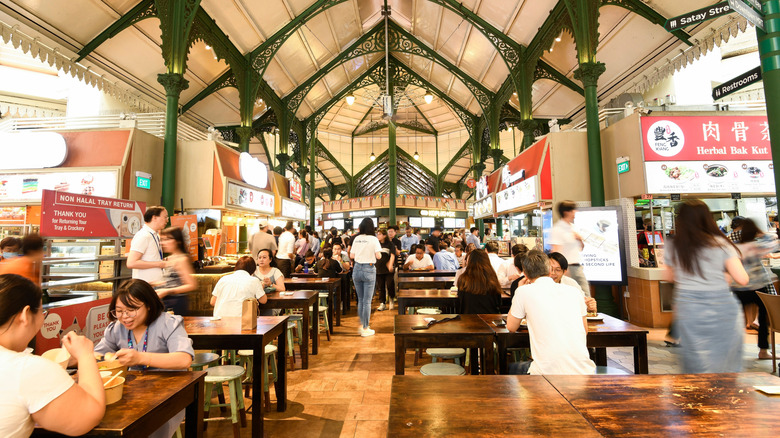The Important, Unspoken Etiquette Tourists Need To Know When Dining Out In Singapore
When traveling to international destinations, it's always a good idea to familiarize yourself with local customs to ensure you're respecting the culture and not coming off as a rude tourist. In Singapore, specifically, there's a rich dining culture that spans from high-end, luxury fine dining to authentic street foods, and each come with their own set of etiquette codes you should abide by when visiting. For the former, some common and expected etiquette includes dressing properly and not using utensils to gesture and point. Meanwhile, for the latter, you'll need to keep an eye out for a common dining practice: chope culture.
"Chope" is a Singlish term that refers to the practice of leaving small items at a table in a food hall or food court to reserve the space. Chope is a derivative of the word "chop," which in Singlish means "to leave your mark." Items you chope with can be as obvious as jackets hung on chairs or even purses sitting on tables (the city is so safe, it's a regular practice to leave valuables unattended), or they can be as small as a packet of facial tissues. This common item is used frequently to chope, which is why you might here locals mention "tissue culture." It's a practical, commonly accepted cultural dining practice for the small nation-city — reserve your table and go fetch your food. This is just one of the many things that make Singapore one of the best places to visit in Southeast Asia; a culture of commonly accepted yet practical etiquette and respect creates a pleasant dining experience for all.
How did chope culture develop?
While in some places in the world, reserving a table in a busy food hall by leaving an item there may come off as rude and inconsiderate, it's an incredibly routinized practice in Singapore. So much so that chope culture has extended beyond food courts and is a common thing to see in other parts of the city where one would want to reserve a spot for later. Chope culture is observable now in places like parking lots and even spaces where prime photo opportunities are sought after. For Singaporeans, it matches an efficient, streamlined attitude that rules the country's sensibilities. In a country as clean as Singapore, where even chewing gum is banned, chope culture provides a sense of order to crowd chaos.
For diners in busy food halls, it makes much more sense to claim a table first, then order your food, returning to the table thereafter to enjoy your meal. To Singaporeans, it's much less precarious then trying to navigate crowds with a tray laden with foods that are often hot, like soups and sizzling meats. A practice once thought to be a bit tasteless — and is still thought of in that way in other countries — chope culture has developed into a dining mainstay in Singapore. There are no hurt feelings when one sees a packet of tissues on an open table — just a mutual agreement that the table is spoken for. Don't be afraid to partake in the cultural practice yourself. No one will get mad at you for doing it the Singaporean way!

